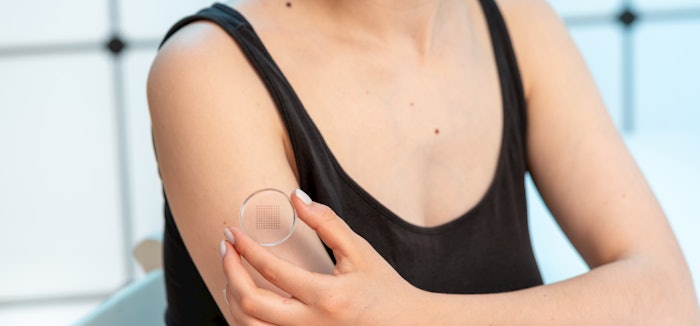
While the stratum corneum serves as the ultimate protective barrier and controls penetration, technologies such as microneedles, dissolvable microneedles, elongated microparticles, -somes and penetration enhancers deliver actives into or even across the epidermis, improving efficacy. Recent research in this space for microscale physical delivery is the focus of this short review.
Microneedles
Microneedles constitute a minimally invasive transdermal drug delivery technology that can physically puncture the stratum corneum to significantly improve skin permeability. These micro devices have a tip diameter ranging from 10-100 µm and a length of up to 1 mm. First patented in 1976, they have been used for more than 35 years to ensure pain-free and efficacious transdermal drug delivery.
The permeability of lipophilic and large molecules is often limited due to the complex lipid bilayers in the stratum corneum. Microneedles, arranged in microneedle arrays and patches, can therefore increase the delivery rate of such molecules, compared with passive diffusion.1 There are, however, important limitations to microneedle use, including reproducibility of delivery profiles, penetration in different body sites, coating and manufacturing.2
Research into the efficacy of microneedles for potential skin treatments has primarily addressed targeted concerns. For example, in one study, a polymer microneedle roller was tested in an animal model for efficacy against skin pigmentation caused by ultraviolet irradiation. Two different interventions were compared – the topical application of hydroquinone cream and pre-treatment with the roller prior to applying hydroquinone cream – by assessing clinical parameters and tissue biomarkers: skin surface and histology, optical coherence tomography (OCT), superoxide dismutase (SOD) activity and malondialdehyde (MDA) concentration.
The results confirmed that while both methods were effective, pre-treatment with microneedles had a better therapeutic effect. These findings hold promise for future clinical applications in skin care, such as for facial hyperpigmentation (melasma) that significantly affects people's quality of life.3
Recent clinical research in South Korea studied the efficacy of biodegradable hyaluronic acid microneedle patches in atopic dermatitis and dry skin. A loaded patch was applied for 6-8 hr in conjunction with a topical cream.
A patch without microneedles was used as a control in a two-week trial involving an intervention three times per week. The assessment included a visual scoring scale for pruritus and skin dryness (L-SCORAD index), skin hydration and transepidermal water loss (TEWL).
Based on the clinical L-SCORAD index, the microneedle patch was found to be potentially effective in ameliorating atopic dermatitis. However, minor adverse events were reported and a large-scale trial is required to confirm these outcomes.4
Dissolving Microneedles (DMNs)
Dissolving microneedles also represent a technology that provides direct, effective and pain-free intradermal/intralesional drug administration for dermatology treatments, to target skin aging or address hyperpigmentation, psoriasis and keloid scars.5 These hydrophilic, mostly polymer-based constructs are capable of creating physical microchannels for the localized delivery of active agents.
Alpha-arbutin and resveratrol, for example, are widely used to reduce skin pigmentation. However, due to their poor solubility and low bioavailability, current topical formulations containing them have minimal effects. One study investigated their delivery into skin via polyvinylpyrrolidone-baseda dissolvable microneedle patches, demonstrating the mechanical strength of the polymer blend, which allowed the DMNs to resist compression and penetrate excised porcine skin. DMN administration resulted in optimized delivery over a 24-hr period. Both in vitro and in vivo studies confirmed enhanced intradermal delivery (∼2.6× higher), compared with a topical cream formulation.
In another clinical study, a reduction in skin melanin index was observed without adverse effects; i.e., DMN application did not affect skin hydration, TEWL or skin elasticity, demonstrating effective targeted delivery to the pigmented skin area.6
Lipophilic compounds, e.g., plant oils or ceramides, benefit the skin by strengthening the barrier. However, their delivery via DMNs is a challenge. A two-phase delivery system combining a lipophilic topical formulation with hydrophilic compound-loaded DMNs (adenosine-loaded DMN arrays) was tested for its potential to improve the skin barrier. In vitro tests confirmed the delivery of actives.
A small clinical trial also compared the efficacy of the two-phase delivery system with adenosine-loaded DMN patches alone. Both systems effectively delivered adenosine; however, the two-phase system demonstrated significantly improved skin elasticity, hydration, dermal density and wrinkles with no adverse effects.7
The researchers concluded that the integrity of the skin barrier is a key factor in skin health and aging, and that enhancing the delivery of lipophilic compounds constitutes an anti-aging strategy. However, they noted formulations with DMNs must overcome limits of this technology;7 humidity, for example.2
Elongated Microparticles for Targeted Delivery
Another novel tool for enhanced micro delivery is high aspect ratio elongated microparticles (EMPs). One study assessed their penetration and delivery characteristics ex vivo and in vivo in a pig skin model using reflectance confocal microscopy. The EMPs successfully penetrated the epidermis and upper dermis.8
Furthermore, their delivery capacity was assessed using two different-length populations of EMPs with the aid of fluorescent dye and confocal microscopy. Results showed a relatively uniform and continuous delivery profile within the upper layers of the skin – seven times higher than that of topical application alone. The authors also observed the delivery of active ingredients to address skin aging, such as vitamins A and B3, was enhanced using EMPs.8
In another study, researchers noted that while microneedles may be the most common topical delivery enhancement technology, they are not skin strata-specific; and that targeting a specific layer of the skin is an effective anti-aging strategy. They evaluated elongated silica microparticles with two different length profiles to focus the delivery of hyaluronic acid into different strata of human skin.9
Results confirmed that long and short (etched) microparticles behaved differently. The etched EMPs penetrated the skin to the stratum spinosum level, while the milled EMPs could reach beyond the dermo-epidermal junction. They concluded using EMPs with defined length distributions, tuned for a specific stratum of the skin, could achieve enhanced and targeted delivery of a specific active ingredient. They also noted the ideal EMP length for cosmetic actives delivery is 106 µm.9
Doubling Enhanced Delivery in the Hands of Consumers
Many formulation systems also have employed chemical penetration enhancers or encapsulated actives in lipid-based vehicles for delivery into the epidermis. These -somes, including liposomes, transfersomes and invasomes, can increase the bioavailability of active ingredients within the epidermal layers – mostly the stratum corneum, depending on an interplay of parameters, e.g., the partition coefficient and distribution profile, due to altered thermodynamic activity.10
Combining chemical penetration enhancers with the aforementioned physical microchannel-generating approaches would increase delivery further, although there is a need for more research with clinically relevant considerations to understand synergies between these systems. While the time to reach steady-state flux or a specific concentration of an active in a skin layer is readily available from low-order models, the integration of epidermal turnover in the study of transdermal kinetics and active reservoirs is key to understanding the real-life scenario optimum application dose and protocol.11
Conclusion
In personal care R&D, opportunities for improved delivery lie in combining physical microchannel generation with chemical penetration enhancers and encapsulation. This could increase the bioavailability of active ingredients and, in turn, product efficacy. However, further research is needed to advance this area of translational research. The industry is only at the beginning of exploring these promising anti-aging strategies.
a Eudragit RL100
References
- Iapichino, M. Maibach, H. Stoeber, B. (2023). Quantification methods comparing in vitro and in vivo percutaneous permeation by microneedles and passive diffusion. Int J Pharm. doi:10.1016/j.ijpharm.2023.12288
- Prow, T. Personal correspondence.
- He, Y. Hao, Y. Yu, R. et al. (2023). Hydroquinone cream-based polymer microneedle roller for the combined treatment of large-area chloasma. Eur J Pharm Biopharm. doi:10.1016/j.ejpb.2023.01.024
- Song, J. An, E. Sung, C. Jeong, D. Lee, G. Park, S. (2023). A comparative study on a biodegradable hyaluronic acid microneedle patch with a needleless patch for dry skin in atopic dermatitis: a single-blinded, split-body, randomized controlled trial. Arch Dermatol Res. doi:10.1007/s00403-022-02400-9
- Decker, I. Logé, T. Hoeksema, H. et al. (2023). Dissolving microneedles for effective and painless intradermal drug delivery in various skin conditions: A systematic review. J Dermatol. doi:10.1111/1346-8138.16732
- Aung, N. Pengnam, S. Ngawhirunpat, T. et al. (2023 June 27). Fabrication of polyvinyl pyrrolidone-K90/Eudragit RL100-based dissolving microneedle patches loaded with alpha-arbutin and resveratrol for skin depigmentation. Biomater Sci. doi:10.1039/d3bm00132f
- Yang, H. Kim, S. Jang, M. et al. (2019). Two-phase delivery using a horse oil and adenosine-loaded dissolving microneedle patch for skin barrier restoration, moisturization, and wrinkle improvement. J Cosmet Dermatol. doi:10.1111/jocd.12768
- Raphael, A. Primiero, C. Ansaldo, A. Keates, H. Soyer, H. Prow, T. (2013). Elongate microparticles for enhanced drug delivery to ex vivo and in vivo pig skin. J Control Release. doi:10.1016/j.jconrel.2013.07.025
- Yamada, M. Dang, N. Lin, L. et al. (2021). Elongated microparticles tuned for targeting hyaluronic acid delivery to specific skin strata. Int J Cosmet Sci. doi:10.1111/ics
- Alvarez-Román, R. Naik, A. Kalia, N. Guy, R. Fessi, H. (2004). Enhancement of topical delivery from biodegradable nanoparticles. Pharm Res. doi:10.1023/b:pham.0000045235.86197.ef
- Simon, L. Goyal, A. (2009). Dynamics and control of percutaneous drug absorption in the presence of epidermal turnover. J Pharm Sci. doi:10.1002/jps.21408










